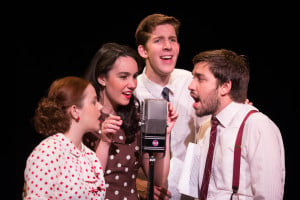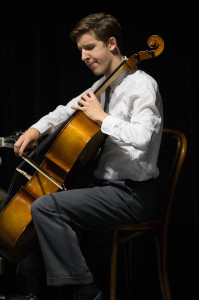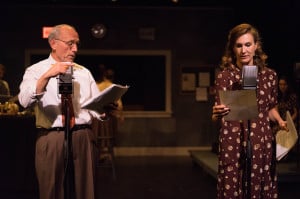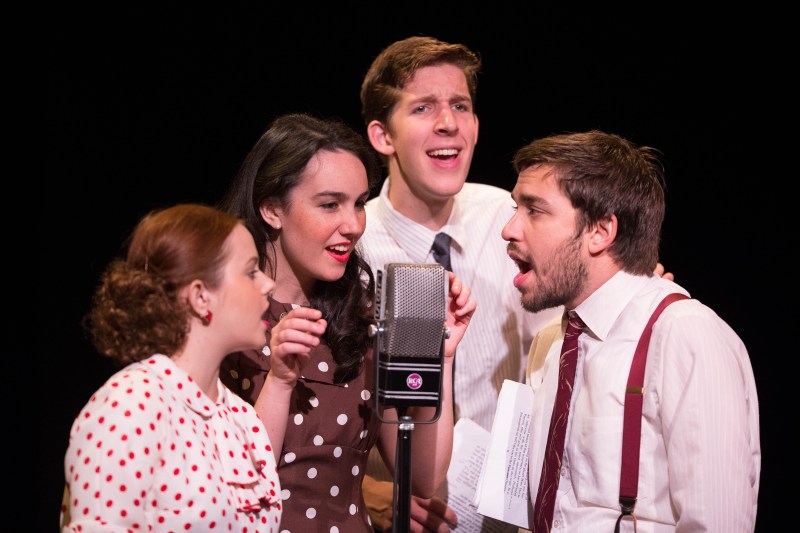
On Friday, Aug. 15, at the Nitery Theater, the Stanford Repertory Theater (SRT) revived the riveting thrill of Orson Welles’ Mercury Theater on-the-air performance of “War of the Worlds,” a radio drama that left an indelible mark on its nationwide audience in 1938.
When this version of H.G. Wells’ science-fiction masterpiece was first aired on the Columbia Broadcasting System, the American public was stirred into a panic. So impeccably were voice drama and sound effects integrated into the performance that many listeners became convinced they were hearing an actual news account of an apocalyptic Martian invasion. Because of the ensuing outrage and mass hysteria, the event is often labeled as one of the most infamous in broadcast history.
Controversial as Welles’ production was, however, it was undeniably one of the most theatrically brilliant radio productions ever to be aired. The SRT captured the spirit of newscasters and voice actors involved in the elaborate production, as well as the enthralling energy of the broadcast itself.
The hour-long performance took place on a floor-level stage in a small auditorium, an atmosphere that would make the performance all the more intimate and engaging. No backdrop was used except for the black walls of the stage and a small back room separated from the main newsroom by a large window. Other props included a few chairs on either side, an old radio atop a table for two and a long table strewn with a collection of odds and ends, cans, strings and glasses.

What makes the SRT rendition of “War of the Worlds” unique is that it reveals the distinctive personalities of each of the voice actors, not just as performers, but as comrades in the newsroom who are united by this ambitious theatrical endeavor. At the start, the newscasters, dressed in 1930s working clothes, mill about the room, scanning their scripts, impatiently anticipating the arrival of their colleagues. Standout characters include the woman played by Courtney Walsh, who whisks into the room with a (fake water vapor-emitting) cigar and lofty air, as well as the small mousy man portrayed by Dante Belletti, who goes off on tangents about the “newest” comic book hero Superman, has his trousers pulled up too high and is mercilessly derided by the others.
As soon as the “on-air” signal flashes red, however, the actors transform into a remarkable team, well-coordinated and well-timed, holding each other’s scripts, collaborating to create intricate sound effects and nodding approvingly at each other at various points in the performance. Their camaraderie is also shown in small gestures, such as sharing a cigarette or clapping each other on the back between entrances.
One of the most fascinating aspects of the production is its impeccable use of sound effects. When Carla Phillips (Walsh) and Professor Pierson (Thomas Freeland) converse in the observatory at Princeton, they talk into large tin cans to simulate the sound effects of talking in a metal-walled room. The cans are used on other occasions to mute reporters’ voices during the chaos of the invasion or to alter the gunners’ voices once they have donned gas masks as protection against the aliens’ toxic smoke. The sound of a bell tolling is created by striking a wine glass with a muffled drumstick while water sounds from the riverside, and various other devices are used to generate an endless range of alien noises.

The actors themselves are extremely versatile at altering their voices to suit different roles or noises, such as animal sounds from the farm in Grover’s Mill or murmurs of an anxious crowd. Whenever it is time for a news anchor to be abruptly cut off, one actor raises an arm and drops it, effectively silencing the entire cast.
This skillful recreation of sound effects largely contributes to the drama of the production, especially the building sense of panic and dread with each of the newscasters’ last moments during the alien attacks with death rays and black smoke. The cries of the crowd swell to fever pitch, the Martians’ otherworldly noises slowly overwhelm the frantic shouts of the humans, and background noises of crashes, rumbles and roars add to the growing frenzy until it is all abruptly cut off when connection with the reporter terminates.
Ensemble music plays between the news bulletins, a stark contrast to the news anchors’ frantic shouts and the whirring of alien machines sounding just moments before. The 1938 production used orchestral tango music in the interim, but ensemble music better suits the small cast and showcases the actors’ individual talents. The multi-talented voice actors switch off singing and playing the guitar, violin and cello during the short musical snippets punctuating the news reports. In particular, Belletti and Sarah Gage stand out as remarkable vocalists.
In the real “War of the Worlds” broadcast, the ending of the alien invasion is narrated by Welles, who explains how the aliens die because of a lack of immunity to human diseases. However, the SRT production dramatizes this part when the cast receives a phone call from a listener who makes very convincing claims that the events they are reporting in their radio production are actually taking place in real life — the smoke, alien attack and carnage. Unsure of what reality really is anymore, the actors decide to put the man on air and broadcast his warning of the alien invasion and his message of hope that the aliens will likely succumb to earthly pathogens they have no immunity against. Welles then steps in at the end with a disclaimer assuring the audience that the broadcast is just a Halloween production and nothing more. He bids the audience good night, and the performance concludes.
SRT’s “War of the Worlds” is a truly exceptional performance, well-choreographed and masterfully executed. It relies on resourceful sound effects, the bare minimum of props and the versatility of a small cast to make an hour-long broadcast an engaging, suspenseful production. While it closely follows Welles’ original production, making only minor alterations to the script, the talented cast brings the 1938 production to life in a unique and electrifying modern rendition that appeals to all audiences.
